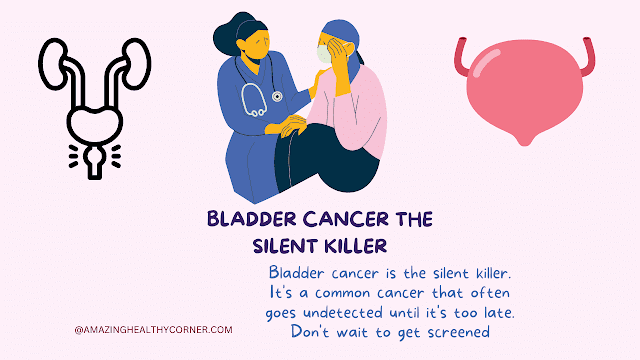Bladder cancer is the silent killer. It’s a common cancer that often goes undetected until it’s too late. Don’t wait to get screened
We’re going to talk about bladder carcinoma, this is an overview and introduction. Bladder carcinoma is a common euro genital cancer, it is common in the elderly and is strongly associated with smoking here. I am drawing a middle-aged person in the toilet urinating. If we’re going into the presentation of bladder cat cancer, it’s important to revise the anatomy. Here are the kidney and the ureter, which brings urine into the bladder, where urine is stored, when the bladder is full urine passes through the urethra and goes out there is the prostate below, the bladder in men and women, there is the uterus which is behind the urinary bladder. Here is a growth in the bladder which signifies or represents carcinoma.
The Truth About Bladder Cancer: The Silent Killer
Let us compare the normal bladder and look at its progression to carcinoma of the bladder. The most common carcinoma is euro thigh glioma which is a tumor from the urothelium. This type of cancer is sometimes referred to as transitional cell carcinoma because at the end of the day these are transitional cells.
The Layers of Bladder Cancer: The Silent Killer
So let us look at the layers of a normal bladder. This is the lumen of the bladder where urine is stored, the inner layer of the bladder is called the euro Psyllium and it is made up of transitional epithelial cells. Below it is the basement membrane which separates the transitional cell. Epithelium with the lamina propria consists of many blood vessels. Below the lamina propria is the detrusor muscle and then we have the adventitia, which is primarily fat the cells within the layer, which are made up of transitional cells can evolve and mutate due to several factors and this will lead to abnormal cells and then progress to Euro the glioma or transitional cell cancer now.
Caught Early, Bladder Cancer is Treatable: The Silent Killer
There are a few types of your urothelium. There’s carcinoma in situ which is essentially carcinoma confined to that layer, you have a sessile tumor or a pillory tumor, which projects out these tumors can then subsequently keep growing, actually grow deeper and penetrate the other layers under it this is where it becomes dangerous the risk factors for developing bladder cancer.
The Silent Killer: Bladder Cancer Symptoms You Need to Know
Especially urothelium is smoking exposure to certain chemicals which won’t be discussed. Cyclophosphamide is a medication Aristo lucky acid age greater than 40 and there are some other minor risk factors which are not mentioned in the signs and symptoms of bladder cancer; including hematuria mainly with or without pain. It’s usually painless hematuria and presentation of this should always ring alarm bells, especially if in the presence of other risk factors, such as age, other signs and symptoms can include renal colic.
Is Your Bladder Making You Sick? Warning Signs of Bladder Cancer
There can be blood clots in the urine dysuria frequency urgency and urinary retention. There can be systemic signs of malignancy including fever, weight loss, and night sweats and therefore the investigation to order upon such presentation is you can do a bedside urinalysis. Urine psychology to look at malignant cells, whole blood camp to check for anemia EUC to check for electrolyte urea creatinine, which is a good marker for kidney function.
Is Your Bladder Giving You the Silent Treatment? Tell-tale Signs of Bladder Cancer
CRP which can identify signs of malignancy inflammation or infection the ultrasound of the bladder and kidney is a very good investigation. For imaging finally, there is invasive cystoscopy, which is the gold standard actually and this is where the bladder can be visualized from within, so you could see the urothelium also with this a biopsy can be formed of the growth of the tumor and this can be subsequently examined.
The Silent Killer: Bladder Cancer Awareness
The most common type of bladder cancer is urothelial carcinoma as I mentioned which is the most common and this is also known as transitional cell carcinoma. There are also other types of bladder cancers including squamous cell carcinoma and adenocarcinoma, after obtaining the biopsy of the tumor within the bladder the tissue is examined for malignancy whether it’s present or not. If malignancy is confirmed, the next step is to stage the tumor because this will then tailor, the management the use of a PET scan or CT scan can help stage the bladder tumor accurately and to see what layers of the bladder are involved and to see if the tumor has spread elsewhere around the body.
1 in 8 men will get bladder cancer in their lifetime – bladder cancer is the silent killer. Don’t wait to get screened
So let us recap the layers of the urinary bladder here, on the top is a bladder lumen again. Which stores urine in the urothelium, which is composed of transitional epithelial cells. Below this is the basement membrane, the lamina propria under it and then you have the muscle layer called the detrusor muscle. There’s an inner and outer part of a superficial and deep below the detrusor muscle is the adventitia, which is the fat layer the World Health Organization staging of bladder tumors includes low malignancy potential which includes carcinoma in situ or t/a which include sessile or papillary tumors the lobe malignancy potential makeup. The majority of bladder tumors are seen after low malignant potential.
The World Health Organization on Bladder Cancer: The Silent Killer
The World Health Organization has the low-grade stage which is where the bladder tumor has grown to the deeper layers and this is t1, t1 involves the growth reaching the basement membrane and the lamina propria. There is t2 a, where the tumor goes past the lamina propria and invades the superficial muscle layer the high-grade stage includes, t2 b which is where the tumor has extended towards the deep layer of the detrusor muscle, t3 is where the tumor has invaded the perivesical tissues, t4 is tumor invading adjacent organs or the tissues of those organs from.
Is Your Bladder Trying to Tell You Something? Warning Signs of Bladder Cancer
Here the tumors can metastasize via hematogenous spread local spread or lymphatic spread the staging of the bladder tumor into low-grade and high-grade is important. It is important because this will tailor the treatment and the treatment will depend on if the tumor has invaded the muscle layer or not, so the management of the treatment focuses on non-muscle-invasive disease and muscle-invasive disease. The muscle-invasive disease has a poorer prognosis than non-muscle-invasive disease treatment. Options include TURBT or TURBt where you respect the tumor essentially or there is a method called intravesical chemotherapy where the chemotherapy agent in liquid form is injected into the bladder and acts locally there.
The Silent Killer: Bladder Cancer Symptoms You Might Be Missing
Finally, there is a cystectomy which is the removal of the bladder. This of course means that the ureter which brings urine down to the bladder has to be reconnected somewhere so that urine can go out somewhere else. Now let’s focus on muscle-invasive bladder carcinoma which as mentioned has a poorer prognosis. Here the patient undergoes neoadjuvant chemotherapy before surgery. Surgery will involve radical cystectomy which is removing the bladder. This will be followed by urinary diversion, this urinary diversion is done to divert the urine flow elsewhere this can be done by taking part of the small intestine joining it with the ureter and creating a stoma or the ureter can drain into the large intestine. Post-surgery chemotherapy is used again as the chemotherapy of choice, nowadays is cisplatin and v flora uracil, however, radiation is also offered with chemo for bladder cancer and thus chemo agents are used very.





